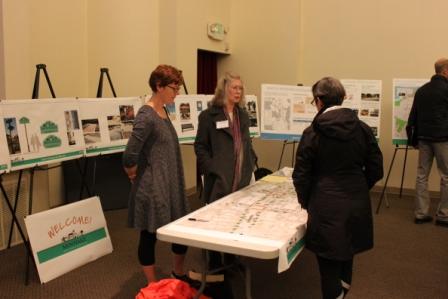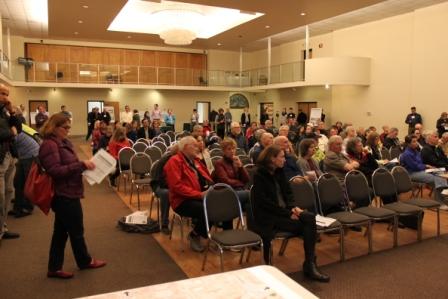Montlakers were once again drawn in for an update from Washington State Department of Transportation (WSDOT). This time the event (Wed, March 22) featured posters with “explainers” and a presentation/Q&A format. Seattle Department of Transportation (SDOT) and Metro/King County representatives were also on hand with information. Present too, were consultants from KPG explaining the Montlake Business District Improvement Plan, an effort led by the Montlake Community Club. Whew! A little confusing with all those presenters! Unfortunately, a query about the future of the Montlake Blvd Market and gas station brought a response that “The matter was under negotiation, so could not be addressed at this time.” BUT there is reason for optimism, because Montlake finally appears to be getting a coordinated response to its traffic concerns.
 The WSDOT spokesperson provided a brief overview of the newly posted Update on the SR 520 Montlake Phase**, with a focus on the Neighborhood Traffic Management plan.
The WSDOT spokesperson provided a brief overview of the newly posted Update on the SR 520 Montlake Phase**, with a focus on the Neighborhood Traffic Management plan.
This Update includes a look, not just at what is happening on SR 520 as reconstruction gets to Montlake, but also a first look at WSDOT & SDOT’s combined ideas for “potential local street measures” right here in Montlake. (Chapter 4 Potential Local Street Measures, pp 24-31).
We are encouraged by this evidence that WSDOT has been listening to us, and has actually been working with the City of Seattle Department of Transportation to respond to the traffic problems we’ve all been telling them about. This could mean genuine mitigation, folks! Please check out the report.
Be sure to leave your comments below once you’ve read the report.

**The SR 520 Montlake Phase includes the construction of the West Approach Bridge South, Montlake lid and interchange, and a bicycle and pedestrian land bridge. Construction of the Montlake Phase is expected to begin in 2018.

Jason Hodin says
so is the next phase funded or not, and if not what is the plan to fund it?
Bruce Balick says
Southbound Metro busses arriving at the bus stop on Montlake Blvd and the SR520 occupy the right traffic lane. There are many such busses every morning, and each of them forces vehicular traffic to squeeze into one lane. Often two or three busses await access to the bus stop. SO traffic can be impeded for ten minutes. When this happens southbound traffic backs up to Hec Ed or beyond. Commuters and residents are affected.
A third lane on Montlake Blvd on the SR520 overpass, where busses can pull out of the two current main traffic lanes, is desperately needed. That is, the SR520 overpass should be widened on its west side.
stephanie Cooper says
From the department of Ecology in Washington:
Q: How loud is too loud?
A: If you are in a residential area, the maximum allowed amount of noise coming into the property is 55dBA from another residential area, 57dBA from a commercial area, and 60dBA from an industrial area.
Hans Kehl says
I was at the Noise Variance session yesterday, April 6th, and do not share this article’s general sense of optimism with the approach that WSDOT is taking.
When WSDOT presented its noise variance request at that meeting, there were a few things to note:
1) The Market and Gas Station were marked as Construction Staging areas. Although no questions were allowed during presentations at the forum (a rule that was militantly enforced), when I asked a communication manager about status of the market and gas station, she replied that the “matter was under current litigation and therefore she could not comment”. When I asked if this meant that the matter was in court, she said “she believed so, but could not comment”.
2) The noise variance, which is for 7 years, 24 hours a day, allows for peak Db levels of 80 Db. World Health Organization has standards in Europe restricting night noise to 40 Db. When comparing peak sound of 80Db to 40Db, on a scale of 1-100, 40 Db would be about 6, and 80 Db would be about 100. Above 55Db, “cardiovascular effects become a major health concern.”
3) An attorney for Perkins Coie, a major Seattle law firm representing Kemper Freeman (landlord of the market/gas station), made a statement during the public comment portion of the meeting. He said that after investigating, none of the supporting documentation for the noise variance request appears to be based upon the Montlake Market and Gas Station being used as a construction staging area. In reality, since such use is clearly part of the plan that WSDOT has, the actual noise will be significantly different from the noise footprint being presented in the variance request. Noisier, and penetrating deeper into our neighborhoods.
The comment period for the noise variance has been extended until April 20th. I encourage everyone in the neighborhood to send in comment. Reference Project # 3027364. Email is: prc@seattle.gov. I also suggest that views be sent out to City Council members and the mayor.